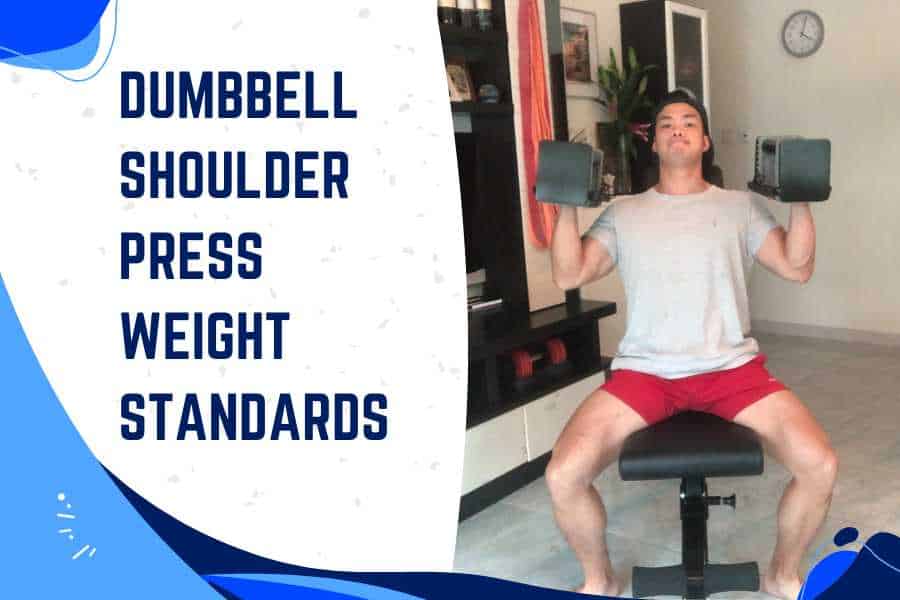For the best shoulder pressing (also called overhead pressing) results, you should be lifting a suitable amount of weight. This post reveals seated and standing dumbbell shoulder press weight standards that allow you to benchmark your performance.
A respectable dumbbell shoulder press for the average male beginner is 25-60% of body weight for 1 repetition and both dumbbells combined. Intermediates and advanced lifters should be able to lift 60-100% and 75-125% of body weight (respectively) for 1 rep.
The weight standards in this post will help you determine what is a respectable weight to be lifting based on your variation (standing vs sitting), gender, body weight, and training experience.
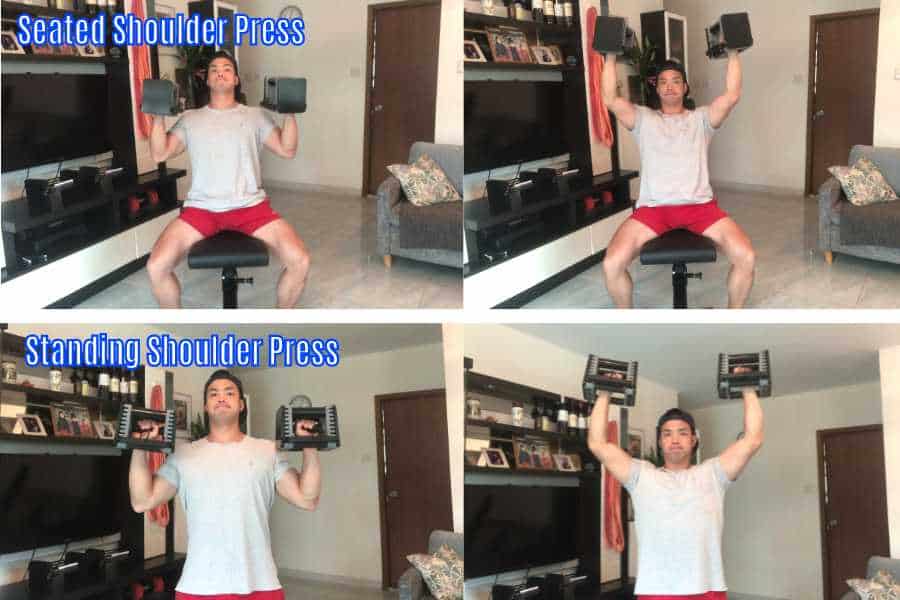
- How To Use These Weight Standards
- Beginner Dumbbell Shoulder Press Weight Standards
- Intermediate Dumbbell Shoulder Press Weight Standards
- Advanced Dumbbell Shoulder Press Weight Standards
- How Good Is Your Dumbbell Shoulder Press Vs Others?
- 5 Reasons Why Your Dumbbell Shoulder Pressing Strength Is Below Average
- Other Weight Standards For Dumbbell Shoulder Press Muscles
- Conclusion
How To Use These Weight Standards

1) Determining your training level:
- Beginners have practiced the dumbbell shoulder press for 1-12 months.
- Intermediates have practiced the dumbbell shoulder press for 12-36 months.
- Advanced lifters have practiced the dumbbell shoulder press for 4 years or more.
2) Choosing your rep range:
The weight standards are given for:
- 1-rep max (1RM)- this is the maximum amount of weight you can lift for a single repetition. It’s often used as a strength standard.
- 6-10 working reps- this is generally considered to be the ideal rep range for building muscle.
3) Selecting your gender and body weight:
- Average dumbbell shoulder press weight standards are revealed for common body weights.
- Male shoulder press standards are given.
- Females can use a 60% conversion (multiply the weight standard by 0.60).
4) Reading the charts:
- Weight standards are given as lbs on the top and kg on the bottom.
- If you’re doing the shoulder press with dumbbells at or above the weight standard for your given training level, body weight, and gender, then you are lifting a respectable amount of weight.
Beginner Dumbbell Shoulder Press Weight Standards
Here’s how much weight you should be dumbbell shoulder pressing as a beginner:
| Bodyweight | Variation | 1-rep max | 6-rep max | 7-rep max | 8-rep max | 9-rep max | 10-rep max |
|---|---|---|---|---|---|---|---|
| 120lb 54kg | Standing | 30lb 14kg | 25lb 11kg | 25lb 11kg | 24lb 11kg | 23lb 11kg | 22lb 10kg |
| 120lb 54kg | Seated | 36lb 16kg | 30lb 14kg | 30lb 14kg | 28lb 18kg | 28lb 18kg | 26lb 12kg |
| 150lb 68kg | Standing | 48lb 22kg | 40lb 18kg | 39lb 18kg | 38lb 17kg | 37lb 17kg | 35lb 16kg |
| 150lb 68kg | Seated | 42lb 19kg | 35lb 16kg | 34lb 16kg | 34lb 15kg | 33lb 15kg | 31lb 14kg |
| 200lb 91kg | Standing | 56lb 25kg | 47lb 21kg | 46lb 21kg | 45lb 20kg | 44lb 20kg | 41lb 19kg |
| 200lb 91kg | Seated | 84lb 38kg | 71lb 32kg | 69lb 31kg | 67lb 30kg | 66lb 30kg | 61lb 28kg |
| 250lb 113kg | Standing | 104lb 47kg | 87lb 40kg | 85lb 39kg | 83lb 38kg | 81lb 37kg | 76lb 34kg |
| 250lb 113kg | Seated | 128lb 58kg | 108lb 49kg | 105lb 48kg | 102lb 46kg | 100lb 45kg | 93lb 42kg |
| 300lb 136kg | Standing | 130lb 59kg | 109lb 50kg | 107lb 48kg | 104lb 47kg | 101lb 46kg | 95lb 43kg |
| 300lb 136kg | Seated | 170lb 77kg | 143lb 65kg | 139lb 63kg | 136lb 62kg | 133lb 60kg | 124lb 56kg |
Weights are for 2 dumbbells combined.
Generally speaking, beginners should be able to do the shoulder press with dumbbells that weigh 25 to 40% of their body weight whilst standing, or 30 to 60% of their body weight whilst seated.
This is for both dumbbells combined and for a single repetition (1-rep max).
Intermediate Dumbbell Shoulder Press Weight Standards
Here’s how much weight you should be dumbbell shoulder pressing as an intermediate:
| Bodyweight | Variation | 1-rep max | 6-rep max | 7-rep max | 8-rep max | 9-rep max | 10-rep max |
|---|---|---|---|---|---|---|---|
| 120lb 54kg | Standing | 88lb 40kg | 74lb 34kg | 72lb 33kg | 70lb 32kg | 69lb 31kg | 64lb 29kg |
| 120lb 54kg | Seated | 70lb 32kg | 59lb 27kg | 57lb 26kg | 56lb 25kg | 55lb 25kg | 51lb 23kg |
| 150lb 68kg | Standing | 118lb 54kg | 99lb 45kg | 97lb 44kg | 94lb 43kg | 92lb 42kg | 86lb 39kg |
| 150lb 68kg | Seated | 110lb 50kg | 92lb 42kg | 90lb 41kg | 88lb 40kg | 86lb 39kg | 80lb 36kg |
| 200lb 91kg | Standing | 160lb 73kg | 134lb 61kg | 131lb 60kg | 128lb 58kg | 125lb 57kg | 117lb 53kg |
| 200lb 91kg | Seated | 176lb 80kg | 148lb 67kg | 144lb 65kg | 141lb 64kg | 137lb 62kg | 128lb 58kg |
| 250lb 113kg | Standing | 198lb 90kg | 166lb 75kg | 162lb 74kg | 158lb 72kg | 154lb 70kg | 145lb 66kg |
| 250lb 113kg | Seated | 236lb 107kg | 198lb 90kg | 194lb 88kg | 189lb 86kg | 184lb 83kg | 172lb 78kg |
| 300lb 136kg | Standing | 232lb 105kg | 195lb 88kg | 190lb 86kg | 186lb 84kg | 181lb 82kg | 169lb 77kg |
| 300lb 136kg | Seated | 292lb 132kg | 1245lb 11kg | 239lb 109kg | 234lb 106kg | 228lb 103kg | 213lb 97kg |
Weights are for 2 dumbbells combined.
Generally speaking, intermediates should be able to do the shoulder press with dumbbells that weigh 70 to 80% of their body weight whilst standing, or 60 to 100% of their body weight whilst seated.
This is for both dumbbells combined and for a single repetition.
Advanced Dumbbell Shoulder Press Weight Standards
Here’s how much weight you should be dumbbell shoulder pressing as an advanced lifter:
| Bodyweight | Variation | 1-rep max | 6-rep max | 7-rep max | 8-rep max | 9-rep max | 10-rep max |
|---|---|---|---|---|---|---|---|
| 120lb 54kg | Standing | 130lb 59kg | 109lb 50kg | 107lb 48kg | 104lb 47kg | 101lb 46kg | 95lb 43kg |
| 120lb 54kg | Seated | 92lb 42kg | 77lb 35kg | 75lb 34kg | 74lb 33kg | 72lb 33kg | 67lb 30kg |
| 150lb 68kg | Standing | 164lb 74kg | 138lb 62kg | 134lb 61kg | 131lb 60kg | 128lb 58kg | 120lb 54kg |
| 150lb 68kg | Seated | 158lb 72kg | 133lb 60kg | 130lb 59kg | 126lb 57kg | 123lb 56kg | 115lb 52kg |
| 200lb 91kg | Standing | 214lb 97kg | 180lb 82kg | 175lb 80kg | 171lb 78kg | 167lb 76kg | 156lb 71kg |
| 200lb 91kg | Seated | 234lb 106kg | 197lb 89kg | 192lb 87kg | 187lb 85kg | 183lb 83kg | 171lb 77kg |
| 250lb 113kg | Standing | 256lb 116kg | 215lb 98kg | 210lb 95kg | 205lb 93kg | 200lb 91kg | 187lb 85kg |
| 250lb 113kg | Seated | 304lb 138kg | 255lb 116kg | 249lb 113kg | 243lb 110kg | 237lb 108kg | 222lb 101kg |
| 300lb 136kg | Standing | 296lb 134kg | 249lb 113kg | 243lb 110kg | 237lb 107kg | 231lb 105kg | 216lb 98kg |
| 300lb 136kg | Seated | 368lb 167kg | 309lb 140kg | 302lb 137kg | 294lb 134kg | 287lb 130kg | 269lb 122kg |
Weights are for 2 dumbbells combined.
Generally speaking, advanced lifters should be able to do the shoulder press with dumbbells that weigh 100 to 110% of their body weight whilst standing, or 75 to 125% of their body weight whilst seated.
This is for both dumbbells combined and for a single repetition.
How Good Is Your Dumbbell Shoulder Press Vs Others?
Here’s the average percentage of people who can shoulder press at a fraction of their own body weight using dumbbells:
| Standing Dumbbell Shoulder Press 1RM Weight (as a fraction of body weight) | % Of People Who Can Do It | Seated Dumbbell Shoulder Press 1RM Weight (as a fraction of body weight) | % Of People Who Can Do It |
|---|---|---|---|
| 0.10x | 100% | 0.10x | 100% |
| 0.20x | 100 | 0.20x | 100% |
| 0.30x | 98% | 0.30x | 99% |
| 0.40x | 94% | 0.40x | 96% |
| 0.50x | 87% | 0.50x | 91% |
| 0.60x | 77% | 0.60x | 82% |
| 0.70x | 64% | 0.70x | 72% |
| 0.80x | 50% | 0.80x | 59% |
| 0.90x | 37% | 0.90x | 47% |
| 1.00x | 26% | 1.00x | 36% |
| 1.10x | 17% | 1.10x | 26% |
| 1.20x | 11% | 1.20x | 18% |
| 1.30x | 7% | 1.30x | 12% |
| 1.40x | 4% | 1.40x | 8% |
| 1.50x | 2% | 1.50x | 5% |
| 1.60x | 1% | 1.60x | 3% |
| 1.70x | 0.7% | 1.70x | 2% |
| 1.80x | 0.3% | 1.80x | 1% |
| 1.90x | 0.2% | 1.90x | 0.5% |
| 2.00x | 0.1% | 2.00x | 0.3% |
Weights are for 2 dumbbells combined.
This allows you to compare your standards with others and determine how good your strength is.
To calculate your dumbbell shoulder press as a fraction of your own body weight, simply divide the weight of your 1RM by your body weight.
For example: if you weigh 180lbs and your 1RM is 50lbs, then you’re lifting 0.28x your body weight (50lbs ÷ 180lbs).
The above chart indicates:
- 75% of people can dumbbell shoulder press (standing) 0.65x their body weight for 1 rep. This represents the lower quartile of lifters and is a respectable weight for beginners to achieve.
- 50% of people can dumbbell shoulder press (standing) 0.80x their body weight for 1 rep. This represents the median quartile of lifters and is a respectable weight for intermediates to achieve. It’s also a realistic target for beginners to aim towards with enough training.
- 25% of people can dumbbell shoulder press (standing) 1.00x their body weight for 1 rep. This represents the upper quartile of lifters and is a respectable weight for advanced lifters. It’s also a realistic target for intermediates to aim towards with enough training.
- 75% of people can dumbbell shoulder press (seated) 0.65x their body weight for 1 rep. This represents the lower quartile of lifters and is a respectable weight for beginners to achieve.
- 50% of people can dumbbell shoulder press (seated) 0.90x their body weight for 1 rep. This represents the median quartile of lifters and is a respectable weight for intermediates to achieve. It’s also a realistic target for beginners to aim towards with enough training.
- 25% of people can dumbbell shoulder press (seated) 1.10x their body weight for 1 rep. This represents the upper quartile of lifters and is a respectable weight for advanced lifters. It’s also a realistic target for intermediates to aim towards with enough training.
5 Reasons Why Your Dumbbell Shoulder Pressing Strength Is Below Average
The deltoids (primary target muscles in the shoulder press) are some of the most difficult muscles to grow.
Here are 5 common reasons why you may find it difficult to do the shoulder press using dumbbells, and why your weight standards are below average.
I’ve also shared solutions for each problem.
These solutions can help to improve your overhead press.
1) Weak stabilizing muscles.
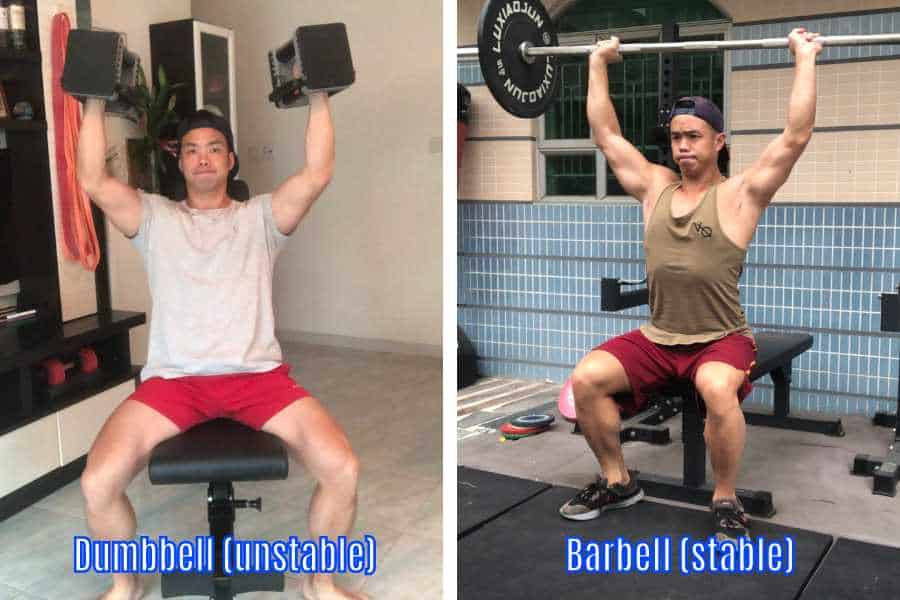
The shoulder press is a compound movement primarily driven by the deltoids and triceps.
But stabilizing activity also comes from the biceps, core, and upper back to help you maintain balance and keep a rigid torso. This is especially true for dumbbell movements that are naturally unstable.
If your stabilizer muscles are weak, then you won’t be able to shoulder press as much weight.
Therefore weak stabilizers can be a major chokepoint in your shoulder pressing strength progression.
Solution:
Your stabilizers will naturally become stronger as you practice the dumbbell shoulder press.
For the smoothest progression, I recommend starting with manageable weights and lifting with good form (see next).
Apply progressive overload by increasing dumbbell weight in small increments whenever you find your current sets becoming easy to complete.
This will force your stabilizers to become stronger over time.
2) Improper form and technique.

The dumbbell shoulder press is a technical move that requires you to apply good lifting form cues to gain the greatest strength-building benefits.
Common beginner form mistakes usually revolve around reducing the range of motion in an effort to lift more weight:
- Half reps. Not bringing the dumbbells down to shoulder level before pressing them back up.
- Cheat reps. Using the hips and legs to generate upward momentum to help press the dumbbells up.
Both of these mistakes can negatively impact your overall dumbbell shoulder press strength progression.
Solution:
Use a suitable dumbbell weight– one that you can manage.
Lift with a full range of motion. Both dumbbells should reach just above the shoulder line before you press them up.
Brace your core before each rep by inhaling and forcing your diaphragm into your stomach.
Make a conscious effort to keep your back straight. A curved back puts strain on your spine and can reduce the amount of dumbbell weight you can lift on the shoulder press.
This is where a good weight bench like the Flybird (link for my review) can really help. The vertical backrest helps to support your back as you press your dumbbells.
3) Using an incorrect rep range
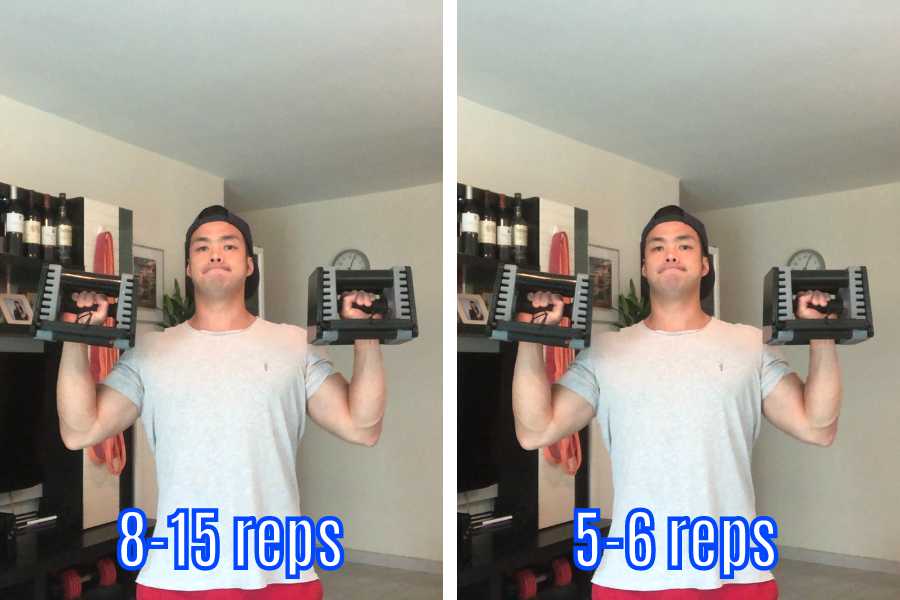
General consensus dictates that lifting in the moderate-high 8-15 rep ranges is best for muscle hypertrophy (growth).
However, the shoulder press is an exception for many people.
It’s not uncommon for beginners and trained lifters alike to struggle to lift high rep ranges when shoulder pressing.
And lifting in an unsuitable rep range can limit your strength progression.
Solution:
Don’t be afraid of trying different rep ranges to find one that’s suitable for you.
I like to reduce to 5 repetitions per set on the dumbbell shoulder press. I find it easier to apply progressive overload when lifting in a low rep range, and this facilitates strength gains.
However, for a low rep range to be effective, you need to be lifting the correct weight.
I recommend using a weight that is 85-90% of your 1RM in the 5-rep range.
4) Misaligned wrist and elbow
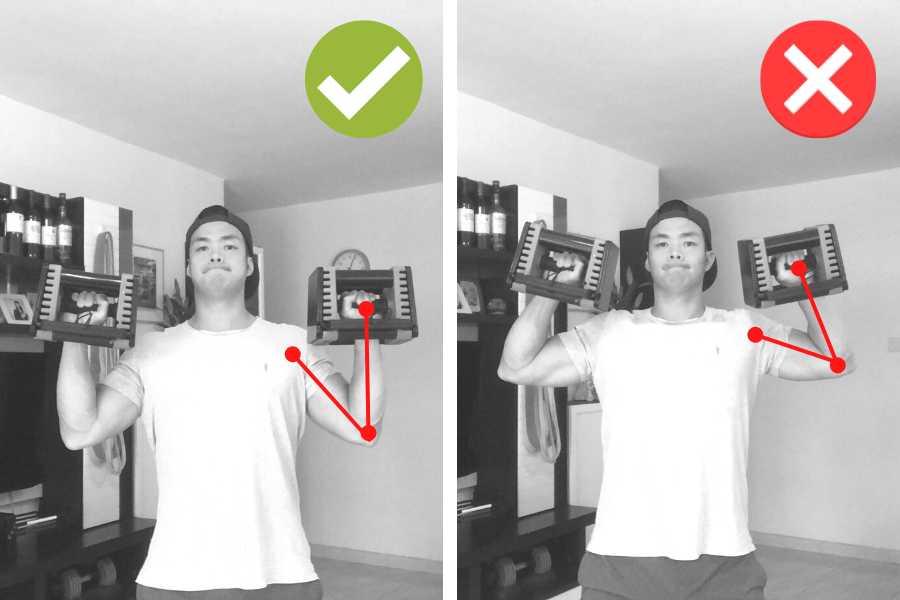
The position of your wrists, dumbbells, and elbows plays a crucial role in how much weight you can shoulder press.
Firstly, if the dumbbells aren’t aligned with your elbows (commonly called an “elbow stack”) then you lose a lot of pressing strength.
Secondly, your wrists become strained if they are hyperextended (bent outwards) or hyperflexed (bent inwards).
Thirdly, your shoulder becomes internally rotated if your elbows flare out too much. And this can cause pain and discomfort.
All mistakes can make the dumbbell shoulder press difficult and cause your strength standards to be below average.
Solution:
Stack the dumbbells by making sure they sit directly above your elbows at approximately 180°.
Tuck the elbows slightly in towards the torso. They should not be flared outwards.
Keep a neutral wrist. This means the flat of your palms should be in line with your forearms.
Applying these 3 form cues should allow you to lift more weight on the dumbbell shoulder press and this can promote the first signs of muscle and strength gain.
5) Not following a bulking diet.

Bulking is crucial to make significantly noticeable size and strength gains.
So if you’re finding it difficult to increase your dumbbell shoulder press, or if you are lifting weights that are below the given weight standards, then it’s worth looking at your diet.
Speaking from personal experience, skinny beginners commonly undereat. And this is a major choking point for strength progression.
Solution:
Go on a bulk!
Determine your maintenance calories using the TDEE calculator and add 5-15%. This is how many calories you should be eating to fuel muscle growth.
Additionally, consume 1g of protein per lb of body weight.
For a complete guide, you can check out my home bulking program for skinny guys.
Other Weight Standards For Dumbbell Shoulder Press Muscles
The dumbbell shoulder press is a vertical compound pushing movement that primarily works the anterior, posterior, and lateral delts, but also the triceps. Here are weight standards for other exercises that hit similar muscle groups:
- Lateral raise– an isolation-type movement that emphasizes the lateral delts.
- Dumbbell bench press– a horizontal pressing exercise that shifts the emphasis from the delts to the pecs.
- Dips– a compound pushing exercise that’s an effective bodyweight alternative to the bench press.
- Tricep extension– an isolation-type movement that works the triceps.
You may also be interested in my other post on the shoulder press world records.
Conclusion
My standing and seated dumbbell shoulder press weight standards help you to determine whether or not you are lifting a respectable amount of weight for your capabilities.
Beginners should be able to do 1 rep using around 25-60% of their body weight (both dumbbells combined).
Intermediates should be able to lift approximately 60-100% of their body weight, and advanced lifters approximately 75-125%.
Exact standards vary widely depending on your chosen variation (sitting vs standing).
If you’re lifting at or exceeding these strength standards, then you’re doing a good and respectable job.
I’ve also shared common problems and solutions to a shoulder press strength that is below average.
You may also be interested in the downloadable Kalibre Blueprint PDF which details exactly how I gained 40lbs of lean muscle (it’s 100% free!). It details the exact exercises and nutrition (with printables) I used to go from skinny to ripped!

